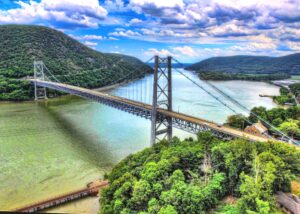
The Bear Mountain Bridge recently turned 100 years old, and now it’s ready for a facelift.
The New York State Bridge Authority has announced a deck replacement project aimed at keeping the bridge safe and reliable for its second century.
The last redecking was back in 1976, and the authority says concrete decks usually last between 30 and 50 years, so it’s time for a new one.
Right now, the project is in the design phase with construction expected to begin in the spring of 2026, and take two years to complete, according to Chris Steber, the authority’s public information officer.
The authority also said the preliminary price tag is $62.1 million, and it will be funded entirely through toll revenue – not state or federal tax dollars.
Since Washington isn’t involved, uncertainty about federal infrastructure spending and grants won’t impact the project.
“In addition to the deck replacement, several complementary improvements are being considered,” said Steber. “These include the widening of the bridge’s sidewalks to meet the Americans with Disabilities Act standards and upgrading drainage systems.”
Also under consideration – overlooks at the bridge towers so people can enjoy the view, and “additional safety and accessibility enhancements” including anti-climb fencing, plus new and improved safety barriers.
State Sen. Pete Harckham says that’s long overdue, posting on X after someone jumped from the bridge in February “We appreciate (The Bridge Authority’s) plans for investment in barriers, which will save lives, but this work must be accelerated in recognition of the ongoing public safety crisis at the Bear Mountain Bridge.”
The Bear Mountain Bridge was an engineering marvel when it opened on Thanksgiving Day in 1924. It was the first span between New York City and Albany that could carry vehicles, and back then it was also the longest suspension bridge in the world spanning 2,255 feet.
It was originally built to help people access Bear Mountain State Park as it got more and more popular, and existing ferry service couldn’t handle the growing crowds.
Since then, bridge traffic has grown exponentially – from 363,000 annual crossings during World War II – to 7 million in 2024, according to the Bridge Authority.
That’s a lot of wear and tear.
“The new deck will provide a smoother, safer driving surface for motorists,” said Steber. It will also “ensure the safety and longevity of the bridge.”
Since it’s a vital artery, the authority says it’s minimizing disruptions by always keeping two lanes of traffic open during construction.
The span also connects the Appalachian Trail – so at least one sidewalk will remain accessible during the two-year project.
The Bridge Authority says it’s keeping residents informed about the project every step of the way.
It hosted a public meeting at the Desmond-Fish Library in March, and more in-person and virtual meetings are forthcoming.
“The first meeting was well attended, and feedback was generally supportive of the re-decking project,” said Steber. “Several community members also expressed support for adding climb deterrent fencing, a feature currently under evaluation. All public comments are being carefully considered as the project evolves.”
The Bridge Authority has also set up a dedicated website about the project, and an email address where people can submit questions and comments.






